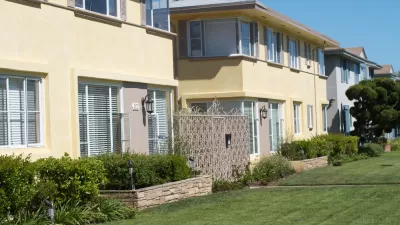A paradigm shift is occurring in the development patterns of American cities -- even the inner cities that have struggled for decades with decay and abandonment, writes Kofi Sefa-Boakye of the Compton Community Redevelopment Agency.
 In his 1962 book The Structure of Scientific Revolution, Thomas Kuhn coined the classic iron law of social change -- paradigm shift: One theory supersedes another primarily because it proved better at explaining the empirical observations that remained anomalous in terms of the earlier theory. The defeat of sprawl and the resurgence of compact development -- the use of smart growth strategies to revive urban America through development of sustainable patterns of mixed-use, walkable, transit-friendly neighborhoods -- is an empirical manifestation of Kuhn's theoretical construct.
In his 1962 book The Structure of Scientific Revolution, Thomas Kuhn coined the classic iron law of social change -- paradigm shift: One theory supersedes another primarily because it proved better at explaining the empirical observations that remained anomalous in terms of the earlier theory. The defeat of sprawl and the resurgence of compact development -- the use of smart growth strategies to revive urban America through development of sustainable patterns of mixed-use, walkable, transit-friendly neighborhoods -- is an empirical manifestation of Kuhn's theoretical construct.
Over the past three decades, urban professionals from various disciplines within and outside academia have finger-pointed suburban sprawl as the key culprit for the continued decay of many inner cities. Metropolitan Los Angeles is an unfortunate example. Businesses that decamped Watts, and Boyle Heights and Compton, for the suburbs, the argument goes, also saddled these communities with empty storefronts, buildings and polluted lots requiring expensive cleanup investments. Massive redevelopment efforts unveiled to stem urban decay in these neighborhoods failed to reverse urban exodus.
Fast forward to 2008. Today these very communities, left for dead, are suddenly enjoying an unprecedented comeback. Like the Phoenix rising from its ashes, Compton last year unveiled an unprecedented $80 million shopping center at its southern fringes and a $40 million residential development to boot right in the heart of its downtown. Boyle Heights to its credit is steadfastly putting finishing touches to a proposed $2-billion upscale commercial and residential development in an area that has been blighted for decades. Watts, a community that has struggled for decades with grinding poverty and crime has become the venue for market rate residential developments. And the list goes on!
Question: Why this sudden back-to-the-city frenzy? What happened to the almighty sprawl? Undoubtedly, a confluence of several factors might have something to do with it. Yet, truth be told, compact growth is trouncing suburban sprawl not because the destructive environmental consequences of the latter have made it unacceptable development policy. Compact growth is flourishing simply because high commuting costs exemplified by oft-cited "pain at the pump" are demagnetizing the suburban mystique and suddenly catapulting compact development into the forefront of urban revival.
Sprawl, the antithesis of compact growth, gained prominence in the LA metropolis and other regions during the '60s, '70s, '80s, and '90s simply because powerful developers and the apostles of the unfettered free market model deemed sprawl the consequence of market choices and hence the epitome of economic efficiency, freedom and property rights. Ironically, during the same period, others took an opposite view of sprawl by arguing that Los Angeles and its haphazard land use portfolio had transformed the metropolis into an unplanned, unchecked, profit-driven growth machine (Calthorpe 1993, 2000). For example during the early years of the current decade, a classic paper from the USC Southern California Studies Center and the Brookings Center on Urban Metropolitan Policy demonstrated the environmental inequities of sprawl by showing graphic evidence of unequal concentration of air pollution and health hazards in LA.'s inner cities (Sprawl Hits the Wall, 2001).
Yet such warnings were not enough to dethrone the politically entrenched proponents of sprawl because sprawl was deemed economically, scientifically and politically good at this specific time – as long as energy is cheap. However, as Kuhn equally pointed out, conventional wisdom, may become subject to question, as facts inconsistent with them come to light. The questioning intensifies as such facts accumulate through time. And conventional wisdom is rarely overthrown unless some alternative theory that accounts for those facts is advanced. Such is the scenario behind the rise and fall of sprawl.
Smart growth developments that enable people to live within walking distance of such amenities as workplaces, shops, schools, parks and transit stops have become a land use reality of the 21st century. Suddenly, the once 'market'-poor communities have become strategic locations for compact mixed use developments that are not auto dependent. Transportation projects that had historically turned inner city communities into dumping grounds for the region's NIMBY projects (highways, freeways and transit routes) have ironically become diamonds in the rough. Transit systems like the Metrolink and the MTA's Blue Line that were once considered symbols of inner city blues have now become symbols of inner city boom – and are enjoying the envy of auto-dependent suburbanites. Along the major corridors of these inner-city communities is a proliferation of mixed-use transit oriented developments (retail, residential and entertainment centers).
As the affluent neighborhoods of L.A.'s Westside shudder and resist the intrusion of the so called Manhattan-style dense mixed-use developments in their fortress-like neighborhoods, distressed urban communities on the other side of town are having the last laugh. If affluent L.A. is giving 'Manhattanization' a luke-warm reception, smart growth is earning a front row seat in the theater of inner city revitalization- a paradigm shift in L.A. land use policymaking indeed.
Kofi Sefa-Boakye is the Redevelopment Director of the City of Compton, California. He holds master degrees in Economics and Urban Planning from the University of Southern California, a doctorate in Policy, Planning and Development from USC, as well as a Knight Fellowship in Community Building at the University of Miami (Florida, 2003). Additionally, Kofi has authored several op-ed articles in the Los Angeles Times and the Los Angeles Business Journal.

Manufactured Crisis: Losing the Nation’s Largest Source of Unsubsidized Affordable Housing
Manufactured housing communities have long been an affordable housing option for millions of people living in the U.S., but that affordability is disappearing rapidly. How did we get here?

Americans May Be Stuck — But Why?
Americans are moving a lot less than they once did, and that is a problem. While Yoni Applebaum, in his highly-publicized article Stuck, gets the reasons badly wrong, it's still important to ask: why are we moving so much less than before?

Research Shows More Roads = More Driving
A national study shows, once again, that increasing road supply induces additional vehicle travel, particularly over the long run.

Judge Halts Enforcement of Anti-Homeless Laws in Grants Pass
The Oregon city will be barred from enforcing two ordinances that prosecute unhoused residents until it increases capacity and accessibility at designated camping sites.

Advancing Sustainability in Los Angeles County Schools
The Los Angeles County Office of Education’s Green Schools Symposium brings together educators, students, and experts to advance sustainability in schools through innovative design, climate resilience strategies, and collaborative learning.

Using Old Oil and Gas Wells for Green Energy Storage
Penn State researchers have found that repurposing abandoned oil and gas wells for geothermal-assisted compressed-air energy storage can boost efficiency, reduce environmental risks, and support clean energy and job transitions.
Urban Design for Planners 1: Software Tools
This six-course series explores essential urban design concepts using open source software and equips planners with the tools they need to participate fully in the urban design process.
Planning for Universal Design
Learn the tools for implementing Universal Design in planning regulations.
City of Moreno Valley
Institute for Housing and Urban Development Studies (IHS)
City of Grandview
Harvard GSD Executive Education
NYU Wagner Graduate School of Public Service
City of Cambridge, Maryland
Newport County Development Council: Connect Greater Newport





























